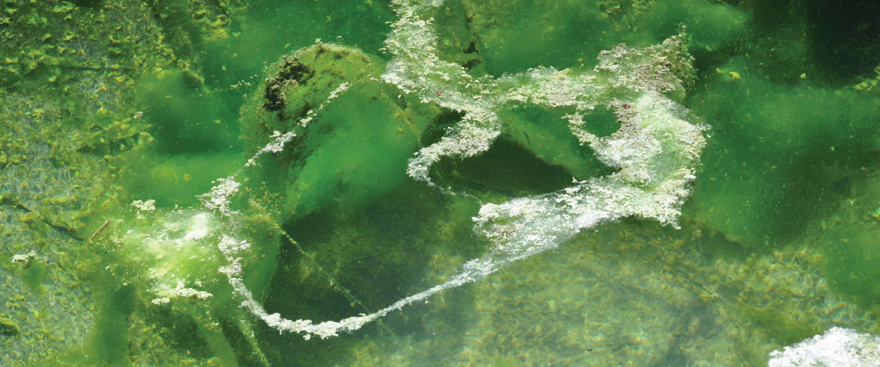Natural water bodies in the US are trending in an unhealthy direction. Many different factors are playing a role in the overall degradation of the water quality in our lakes, ponds and other freshwater resources. Warming trends, increased surface runoff due to development, and the resulting nutrient pollution are some of the more notable negative impacts which often lead to eutrophication of our natural freshwater resources. Traditional methods have long been used to deal with the symptoms of increased eutrophication, but newer technologies offer a superior solution to address the root causes instead of just the symptoms of this phenomenon.
Eutrophication is a term describing a process in which excess nutrients (phosphorus and nitrogen) accumulate in a body of water, resulting in an increased growth of photosynthesizing species that can cause undesirable symptoms i.e. harmful algal blooms that can often be toxic to humans and animals. Excessive algal blooms are also often linked to fish kills that can occur from the resulting oxygen depletion.

While eutrophication is a natural process that typically takes place over many hundreds of years, as intensified agricultural production, development, and other human activity has accelerated in the past 50 plus years, so has nutrient pollution. The surface water runoff of fertilizers, other nutrient-rich sediments, and wastewater treatment are the most significant contributors to this problem. These excess nutrients typically find their way into a body of water through stormwater runoff, where they then can be used as a food source for aquatic plants and algae to grow. When eutrophication occurs, high density blooms happen more frequently. The blooms invariably die off, with the degradation of this biomass by respiring bacteria leading to anoxic (low oxygen) conditions, which then leads to the demise of aerobic bacteria that help keep a body of water balanced. These anoxic conditions can be severe enough to kill invertebrates and fish, changing the entire aquatic ecosystem.
Excessive algae blooms interfere with the use and enjoyment of our surface waters, whether that be for drinking, recreation, irrigation, or natural aesthetics. Potentially more concerning are the human health concerns that result from the toxins that can be released by toxic algae (Cyanobacteria). These toxins have been linked to ALS, Alzheimer’s, Parkinsons, and other neurological and health disorders, which coincidentally or not, have also increased in prevalence over the same time period.
EPA registered aquatic herbicides and algaecides have long been used to keep the symptoms of nutrient pollution (i.e. algae) in check. Copper-based algaecides are the primary choice for lake and pond managers to control algae growth. As more people question the sustainability of this method, newer technologies have come to market focused on a preventive versus a reactive treatment approach, addressing the root causes versus just the symptoms. Products that either bind available phosphorus or increase the dissolved oxygen in water have grown in use in recent years, as both methods help to address the nutrient loading in water bodies by controlling nutrient cycling.
There is now a breakthrough technology, proven remarkably effective in Europe, that is now being introduced into the US. The formulation binds phosphates by driving the natural formation of apatite, eliminating it as a nutrient source while simultaneously releasing oxygen into the water body and helping to balance pH. Unlike typical phosphorus locking technologies, this superior solution leaves no residues or inert materials behind. This is the next phase of innovation that will be needed to solve the world’s water sustainability challenges.
Lake management is still in the early stages of a paradigm shift. Continued emphasis will be placed on solving the root causes of eutrophication and away from treating the symptoms of this phenomenon. While continued efforts to minimize the way that nutrient pollution gets into a water body are necessary, it is imperative that we work now to mitigate the lakes and ponds that are already impaired from years of excess nutrient accumulation. It is time to rethink our approach and reimagine what is possible.

Email [email protected] or call 330.286.6519 to discuss innovative and value-based solutions for all of your lake and pond management needs.
After decades of success in Europe, Oase Professional brings its award-winning Lake Therapy technologies and solutions to the US to help combat your toughest lake and pond problems, whether it’s too much organic sludge, too many nutrients or too little oxygen. We supply innovative product solutions, that are holistic and environmentally friendly, to lake and pond management companies, golf courses, municipalities and others, using nature to our advantage and leaving nothing behind but beautiful, healthy water.


